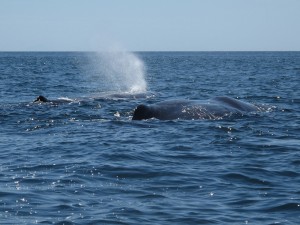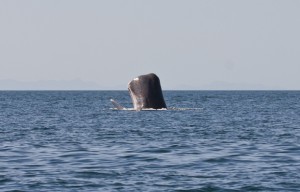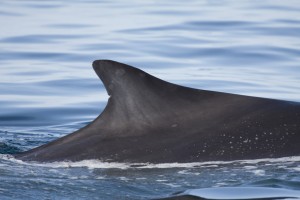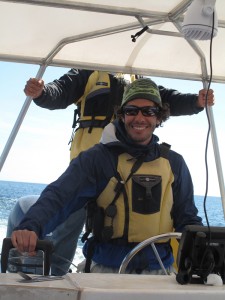We were back on the boat, bright and early. Except this time around, there were hardly any waves and the water was like glass. I was extremely happy that the trip was expected to be smooth sailing, because I really didn’t need another thigh workout after the bumpy ride back from our first boat trip. Today’s mission was simple: whale watching. And did we find any? Oh yes we did, a lot of them too.
 Looking for whales on the panga.
Looking for whales on the panga.
The first whales we approached between Isla Tiburon and Isla San Esteban were sperm whales. The initial excitement of finally seeing a whale was overwhelming. The boat was like a puzzle board where everyone tried to move around and find a good spot to fit into while making sure that Mateja and Luke weren’t on the same side (otherwise we would’ve had some unwanted swimming with the uneven weight distribution). Hector, the marine mammalogist at Prescott, had prepped us by explaining the different blow patterns of whales. For sperm whales, we were to look for a blow that had a slight incline to the left and the most important part of the sperm whale for photo identification was the fluke or the tail. This is unique to sperm whales and was only seen when they dove.
- The fluke of the sperm whale before it takes a dive to feed. (Courtesy of Abram Fleishman)
They were feeding when we arrived, so they would surface and rest while we stealthily followed them from behind and then dive and resurface after 20 or so minutes. The whales could be differentiated by looking at scratches, peels or ridges on the flukes that are unique to the individual. For instance, we can see the peeling skin and distinct ridges of some sperm whales in the photos below.
- Ridges on the sperm whale fluke that can be used to identify individuals. (Courtesy of Abram Fleishman)
When the sperm whales surfaced, some would jump out of the water and the amount of water it displaced was just absolutely incredible. There was also one whale that came up head first, which unfortunately I completely missed. Good thing it was caught on film so at least I can pretend that I saw it myself.
- A sperm whale decides to pop up and say hi to us! (Courtesy of Abram Fleishman)
After the sperm whales, we decided to try our luck with the fin whales that were close by. On our way, we ran into two separate pods of dolphins that were extremely “playful”. They were really just going nuts when our boat pulled up close as you can see in the picture. Riding on the bow when all this happened was probably one of the highlights of my entire Mexico trip although I was completely soaked by the end of it.
- Dolphins playing with us and jumping completely out of the water.
Here is a video that Ted made of what we saw on the bow. Be prepared to be mind-blown by the acrobatics of our dolphin friends: http://www.youtube.com/watch?v=WVgmB-xbYEQ
Luckily for us, we didn’t have to go that far to see a ton of fin whales. They were a lot easier to spot because the area they were in had really calm water and their blows went much higher vertically. Fin whales and most other cetaceans (except sperm whales) are identified by their dorsal fins. The ridges, coloration and parasites that might be found can help to characterize individuals.
At one point, we were just surrounded by the whales and stopped the engine to hear their breathing and swimming. It was a magical experience for me because I am very interested in fin whales and being in close proximity to such a large number of them and hearing every little move they made was just phenomenal.
All in all, there were definitely a couple surprises on this “rest day” trip:
1) The number of whales and dolphins we saw and what they did;
2) We all survived Xavier operating the boat for a while;
- Xavier attempts to operate the panga… we’re still alive.
3) Nari managed to hold her need to use the bathroom for the whole day despite Elena’s excellent demonstration on how to pee on the boat.
- Elena demonstrates how to properly use the bathroom on a boat.
My conclusion from that day? Rest is for the weak.










